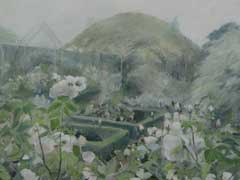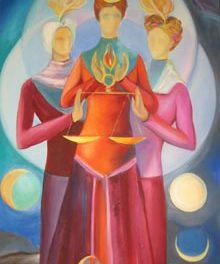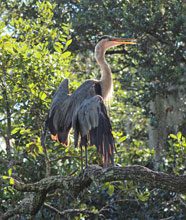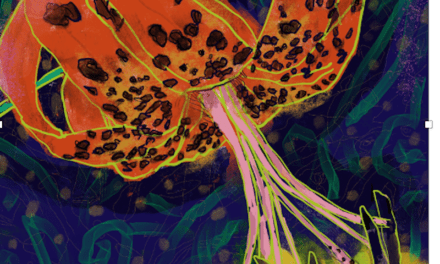 “Encounters”, the first solo exhibit of paintings by Pat Whitehead in South Carolina, will be held at University of South Carolina Beaufort Center for the Arts October 16 through November 10. A reception for the artist will be held Friday, October 22 from 5:30 pm until 7 pm at the USCB gallery on Carteret Street and is open to the public. The gallery will be open for the length of the show Monday through Friday from 9 am – 5 pm.
“Encounters”, the first solo exhibit of paintings by Pat Whitehead in South Carolina, will be held at University of South Carolina Beaufort Center for the Arts October 16 through November 10. A reception for the artist will be held Friday, October 22 from 5:30 pm until 7 pm at the USCB gallery on Carteret Street and is open to the public. The gallery will be open for the length of the show Monday through Friday from 9 am – 5 pm.
Arriving in Beaufort with her husband, she decided to spend her initial time in the low country exploring this connection to her natural environment and embarking on a new direction of painting.  The “Wave” series was begun in earnest about 5 years ago, often recalling seas of the Caribbean as well as Europe and the United States. Slowly, the same progression of visual connection between private viewer and nature overlapped in to the “Branches” series. Being surrounded by decades old live oaks and magnolias may have been the trigger, but however it began it continued for another season, and stretched to vistas of Maine, England and beyond.
The “Wave” series was begun in earnest about 5 years ago, often recalling seas of the Caribbean as well as Europe and the United States. Slowly, the same progression of visual connection between private viewer and nature overlapped in to the “Branches” series. Being surrounded by decades old live oaks and magnolias may have been the trigger, but however it began it continued for another season, and stretched to vistas of Maine, England and beyond.
“My memories and emotions mirror my recalled encounters with new surroundings when I am making a picture. I often travel looking for a motif that will transport me to a fresh visual field and make an impact. There are infinite possibilities of new discoveries outside the familiar. Reinterpreting the scene in my studio revives the sounds, smells and feel of the moment with the added dimension of having had the luxury of time to simmer the images in my recollections,” the artist explains.
 “It is important to me to guide the viewer in to my scenes and allow them to create their own world built on my experiences. The connection will be personal for each individual based on his or her history and mood. But hopefully, the painting will add a new dimension of memory that will linger.”
“It is important to me to guide the viewer in to my scenes and allow them to create their own world built on my experiences. The connection will be personal for each individual based on his or her history and mood. But hopefully, the painting will add a new dimension of memory that will linger.”
In the latest paintings done in the past year, Whitehead has begun to entangle people in her scenes. The soulful stories involving the natural world have taken on a new dimension with the addition of “players”. Surroundings affect the participants in a unique way, and vice versa. In “Valentine’s Day” different groups celebrate the holiday in their own fashion. What is interesting in the scene is how the “valentines” gravitate to spaces in the gardens of the Getty Museum in LA beneath the barren trees of February and the garden paths. The space directed their encounters. In “Garden Club”, the botanic lovers of a Beaufort garden weave through the beds in a definite pattern with each individual or group having their own role in the scene. Again, they are engaged and directed by their surroundings, and of course, this is often a gardener’s intention. These classic layouts invite the visitor in, and then  enfold them in the enclosures. In “White Garden”, the lone figure becomes part of the mystery in this carefully designed historic garden at Sissinghurst in England. There is perhaps an encounter imminent in the hidden shadows beyond her path. With sparse detail, we can only imagine the relationships and determinations of the players in these paintings. This makes the viewer of the picture an active participant. In the various “At the Beach” paintings, the people and umbrellas on the beach have created their own wave patterns on the sand, ebbing and flowing as they encounter each other and the sea.
enfold them in the enclosures. In “White Garden”, the lone figure becomes part of the mystery in this carefully designed historic garden at Sissinghurst in England. There is perhaps an encounter imminent in the hidden shadows beyond her path. With sparse detail, we can only imagine the relationships and determinations of the players in these paintings. This makes the viewer of the picture an active participant. In the various “At the Beach” paintings, the people and umbrellas on the beach have created their own wave patterns on the sand, ebbing and flowing as they encounter each other and the sea.
“The balance of desire to be alone with our environment or share it with others, and how our surroundings help determine that interaction, is intriguing for me as an artist. It creates a particular tension for the people in the scenes as well as the observers. Often, I think, our surroundings orchestrate the focus of the encounters we have.”
Pat Whitehead’s work can be viewed on her website at www.patwhitehead.com. Her work is in many private collections both in the United States and abroad.








